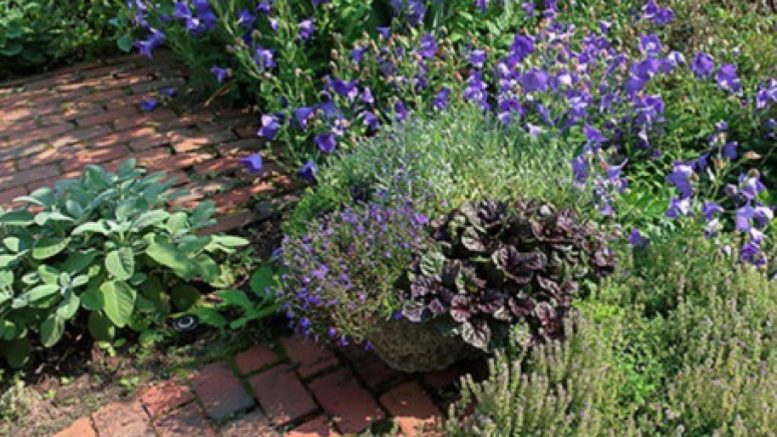As people are forced to spend more time at home and existing concerns about the food supply chain grow, it is natural for homeowners to turn to their landscapes. Landscaping professionals are uniquely positioned to help homeowners with design ideas and advice.
I wouldn’t be surprised to see a strong resurgence of the old-fashioned victory garden, or more aptly, pandemic garden, this summer. Landscapes not only supply ecosystem services such as aesthetics, wildlife habitats, pollinator support, but with a little knowledge and creativity will also support a variety of edibles. Be sure that competing weeds are controlled before planting your edibles, it is almost impossible to treat with herbicides after planting.
Taking care to interplant edibles in areas where growing needs are similar to existing plants is one of the keys to success. Consider moisture, light, drainage, and fertility when designing the edible landscape. Design principles are the same, consider texture, line, form, color when considering mixing edibles with landscape plants. Also, think about the growth habits of both the edible and traditional landscape plants. You don’t want your plants duking it out for growing space.
Let’s first talk herbs
In general, herbs are easy to grow, requiring low nutrients, plenty of sun, and in some cases, minimal water. Herb aromatic foliage contains oils that deter herbivory from both mammals and insects. There are quite a few landscape friendly herbs with attractive foliage and flower to complement other plants. Consider Salvia Officinalis, garden sage: a color echo of tricolor sage under pink roses, S. officinalis ‘Aurea’ around Chrysanthemum x superbum ‘Becky’ echoing the golden centers of the daisy, or to contrast the luscious finely dissected foliage of Sambuca nigra ‘Black Lace’.
For those of you who grow Artemisia ‘Huntingdon’ or ‘Powis Castle’ think of the clear blue flowers of borage, blue African basil, or the pink flowers of chives. The foliage of all also provides contrasting textures to add to the composition. Other popular common herbs are oregano, thyme, and basil. The toughest oregano for our state is Oreganum vulgare subspecies hirtum, Greek oregano, whose creeping habit is aggressive enough to be treated as a groundcover, just pull at will. Oregano laevigatum ‘Hopley’s Purple’ is a tough, drought-tolerant, sun-loving oregano that has ornamental purplish-red flowering heads made up of thousands of individual flowers. The purplish-red flowering heads combine well with the flowers of ‘Terra Cotta’ yarrow or orange Gaillardia. O. laevigatum ‘Rosenkuppel’ is another ornamental variety of oregano and both ‘Hopley’s Purple’ and ‘Rosenkuppel’ are displayed to good advantage next to any silver foliaged landscape plant. Sunny spring-leaved golden marjoram, (O. vulgare aureum) makes a bright spreading, tough, groundcover, becoming greener as the season progresses. Thyme has many varieties, lemon, lime, orange and plain, there is one for everyone. Thyme vulgaris (common) and Thyme citriodoris (lemon) are most commonly used in cooking while T. pseudolanuginosus and T. praecox (wooly and creeping) hug the ground and are used between stepping stones and in rock walls.
No discussion of popular herbs is complete without mentioning basil. Basil is an essential element of pesto and many tomato salads and sauces. (Not to mention a fun addition to several cocktails). Traditional pesto basil includes large-leaved Genovese, but newer varieties such as ‘Rutgers Devotion’ are bred for resistance to downy mildew. If you want to grow basil for aesthetics as well as taste, try African Blue basil or the variegated variety ‘Perpetua’. African Blue basil has a pink flower with dark purple calyxes. These attractive flowers can also be used sprinkled over pasta, salads or frozen in ice cubes for cocktails. Actually, don’t forget to use borage in the same manner!
Take tip cuttings of African Blue basil in late summer, early fall, and once rooted grow in a pot indoors until the following spring. Basil varieties ‘Perpetua’ and ‘Emerald Towers’ both have columnar forms that help them fit into tight spaces. Perpetua is attractively variegated and doesn’t flower like other basils, so the taste never becomes bitter. Basil is an annual and can be planted by seed throughout the season ensuring a long period of harvest before losing your plants to flowering. Sage, oregano, thyme, and basil love full sun. All prefer well-drained soils although basil can use more moisture than the others. For sage, oregano, and thyme cut back in spring eliminating any dead portions.
Lavender and rosemary are traditional edging plants that can be used as a garden border while providing edible flowers and fragrant foliage. Hidcote and Munstead varieties of English lavender, Lavandula angustifolia, are reliably hardy in Pennsylvania. Rosemary is best grown as an annual or grown in pots and brought indoors for the winter. Neither will attain the height or magnificence of the hedges seen in English and French gardens, we just don’t have the climate.
Yes, those of us that live in areas with high deer populations have more of a challenge, but this is not insurmountable. There are some edibles that are less attractive to local wildlife, such as artichokes, herbs, onions, garlic, peppers, and beans. Before the fruit is formed plants can be sprayed with deer deterrents so deer do not establish the habit of feeding. This is not foolproof but can help. You may also want to protect your beans and pepper plants with cages around the base of the plants to protect from marauding rabbits. If you use pole beans the beans themselves will be out of reach of smaller herbivores. You can also try surrounding the plants with landscape plants unattractive to deer such as Crimson Pygmy barberry, false plum yew, and artemisia.
Edible flowers are another option
The peppery, attractive flowers of nasturtiums are cheery landscape additions as are calendula and dainty Johnny Jump Up blooms. The nasturtium petals add texture and color to salads while Johnny Jump Up blooms can be coated with egg white and sugar, candied, and added to desserts. Some herbs, mints, in particular, can be aggressive spreaders and so historically are discouraged for landscape use. You can embrace this tendency and use a mint as a groundcover. I like the cream and green scented foliage of pineapple mint and have used this under heirloom albas and hybrid musk roses.
Kales and other greens can also mix well in the landscape. The beautiful leaves of red-leaved lettuces such as ‘Lollo Rossa’, blue-green foliage of ‘Red Russian’ kale, and the frilly foliage of mustards all add to the home landscape. Letting some herbs go to flower not only provides more plants for the garden but also extends the use of the plant. Cilantro flowers are delicate and white and have a milder cilantro taste. Many garden designers rave about the texture and color of bronze fennel in the landscape but I would add a strong caution, do not let it go to seed or you are likely to have a new bronze fennel groundcover. Unfortunately, all of these herbs are desirable as salad greens to more than homeowners. It can be very difficult to discourage deer, rabbits, and groundhogs from adding these healthy and beautiful plants to their diet.
Landscapers in the time of Covid, should be taking advantage of this emerging trend. Provide training to employees on the design and care of edible landscapes and add this to your portfolio. There are many challenges that have been added to our business lives, but there are always opportunities for those who are clear-eyed.
This educational blog is a series of informative articles from the Penn State Master Gardeners volunteers plus news concerning the group and their activities. For more information, click here.



































